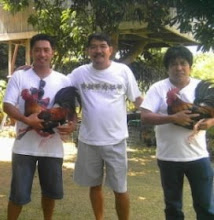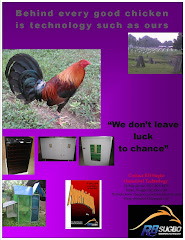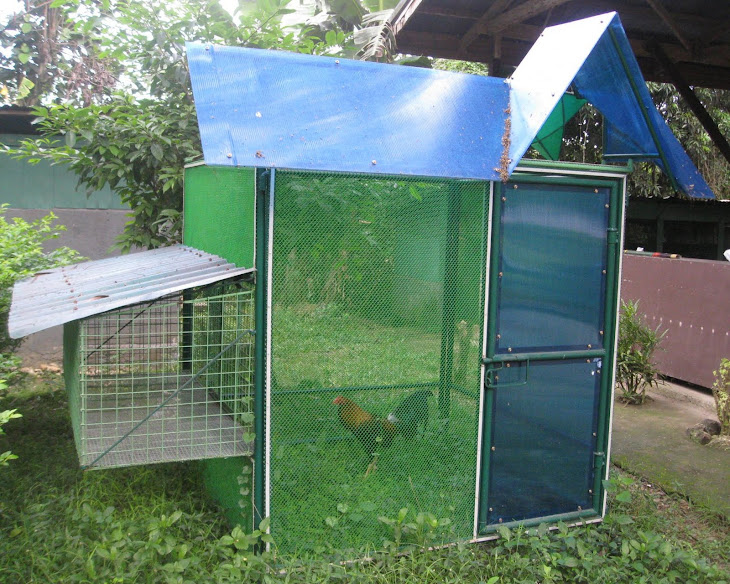
Written for and published in
Pit games Magazine
Secrets I learned from the Masters
By Rey K. Bajenting
RB Sugbo Gamefowl Technology
After I wrote in Pit Games No. 6 that I breed and sell cocks, queries and orders started to pour in. Some of the queries elicited answers that might turn out useful and informative to fellow cockers. Thus, I decided to share the following with you.
Q. What is the difference between infusion and intervention as you wrote in your article “The Sugbos” in Pit Games No. 6?
A As I understand infusion is adding a new blood to your existing bloodline, and then, slowly breeding the new blood out until only a quarter, an eight or a sixteenth remained. The object is to achieve slight genetic variation that will serve as a shot in the arm to your existing bloodline, without regard whether or not the phenotype of the new blood will manifest. Mostly, you would rather that the new phenotype does not show. Intervention, on the other hand, is a termed I coined to denote the introduction of a certain phenotype that you want manifested in your existing bloodline. For example, in developing my Blakliz, I injected the brown red blood into my sweaters and then I slowly bred out the brown red blood by continuing the in-breeding program of the same sweater blood yet maintaining the brown red plumage. It is sort of an intervening move at some point of your in-breeding program to introduce a certain trait you wanted manifested in your existing bloodline.
Q. What is this bloodline of yours called Ponkans?
A. They are a family of sweaters. I called them ponkans because I called the original sweater brood cock from EDL/Excellence of Doc. Ayong Lorenzo by the name ponkan. I started by mating ponkan with one of the original hens of the trio. Then by repeatedly breeding back to ponkan producing 3/4s. 7/8s and 15/16s of ponkan. In every generation I try to lock the genes by selective brother-sister mating. I hope to proceed with the bro-sister matings to produce sub families of ponkan 3/4s, ponkan 7/8s and ponkan 15/16s which I could, in the future, out breed to one another.
Q. You are breeding the Aguirre greys, what do you like in them?
A. Before I acquire the aguirre greys of Mayor Juancho Aguirre and that of his nephew Mark, I was already observing the performance of these greys. And, in my humble opinion the Aguirre greys are the best greys for the long knife. Perhaps, because Mayor Juancho bred and designed his greys precisely for the long knife. The AGs are smart, excellent cutters, high flyers, much quick for a grey and, game as greys should be.
Q. You sell the sugbos at relatively low prices, does this mean they are not at par with the best?
A. Like the top-quality birds of top breeders, the Sugbos come from splendid bloodlines acquired from the originators themselves or their agents. They are hen-brood and free-ranged, and then long corded. Indeed they are hardened and provided with proper nutrition every step of the way. With all the technology we put unto them, the sugbos have the makings of the best there is. If, however, they could not compare with the birds of the other big name breeders, then it could only be due to my own limitations as a breeder with less experience than the others. We are doing our best, though, to enable the Sugbos to compete as equal in any pit against the best.
Q. You wrote that your birds have to pass a strict selection process in their fighting ability. What fighting traits do you look for in a cock?
A. Since we are fighting in the long knife, I regard cutting ability more than gameness; quickness more than power; timing more than speed; and intelligence more than staying power. And, an ace cock does not have a particular fighting style. It is not a flyer, it is not a grounder, it is not a shuffler, it is not a counter puncher. But when, circumstances demand, it could be any or all of the above.
Q. Do you single mate?
A. Yes, I always do for my inbreds and those that I breed to breed. There should be no doubt as to the pedigree of the fowl you use for breeding.
Q. What about for your battle crosses?
A. For battle crosses we use the yard mating. Of course, with the trap-nest method. For example last season in producing our ponkan crosses, we had four yards, each with six hens. Two lemon guapo hens, 2 lemon 84 hens, and 2 roundhead hens, Then we threw one ponkan brood cock into each of the yards. Since we use trap nests we could mark accurately to the last egg. With the system we could identify not only which bloodlines cross well with the ponkans but also which particular hens crossed well with which particular brood cock. Out of the 24 variations, we had identified 7 super nicks. These nicks will all be repeated this year. There were four total flops. They will be discarded. In addition we have discovered that the ponkans generally blended well with the 84s. So this year we will apply the reciprocal recurrent method between the two lines.
Q. You are developing your own sugbo lines such as the ponkans and the blakliz, how do you go about it?
A. There are so many ways of doing it. For a starter, why don’t you get a copy of Dr. Andew Bunan’s book : Lihim sa Pagbuo ng Sariling Linyada.












